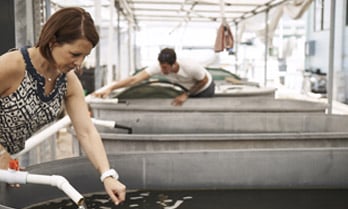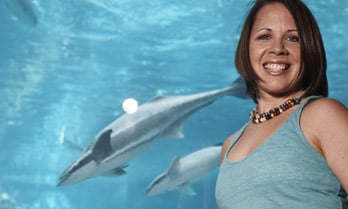Dr Joanne Whittaker, Institute for Marine and Antarctic Studies, University of Tasmania
01 September 2013
How Australia and India broke up—100 million years ago
Jo Whittaker likes to solve jigsaw puzzles, and as a marine geoscientist she is tackling the biggest puzzle on the planet—the formation of continents.
With the help of Australia’s national marine research vessels, and her L’Oréal Fellowship, Jo is reconstructing how the Indian, Australian and Antarctic tectonic plates separated over the past 200 million years, forming the Indian Ocean and the continents as we see them today. This information will help us model climate change better, find new gas resources, and understand the dynamics of the land in which we live.
Qualifications
| 2008 | PhD (Geophysics), The University of Sydney |
| 2005 | Master of Geophysics, Victoria University of Wellington, New Zealand |
| 2003 | Bachelor of Science with Honours (Geology)/Bachelor of Commerce,The University of Sydney |
Career highlights, awards, fellowships, grants
| 2013-present | Marine Geoscientist, Institute for Marine and Antarctic Studies, University of Tasmania |
| 2013 | Edgeworth David Medal, Royal Society of NSW |
| 2012-2013 | Chief investigator on three separate grants (from CSIRO and Schmidt Oceanographic Institute) for a total of 16 weeks’ ship time (worth almost $5.5 million) on Australia’s Marine National Facility research vessel Investigator |
| 2011 | Invited speaker, 36th Professor Harry Messel International Science School: Light and Matter, Sydney |
| 2010 | NSW Tall Poppy Award, Australian Institute of Policy & Science |
| 2010 | Lead chief investigator on grant for three weeks’ ship time (worth almost $1 million) on Australia’s Marine National Facility research vesselSouthern Surveyor, funded by CSIRO and Statoil |
| 2010 | Invited speaker, Austral Portals Symposium, New York, USA |
| 2009 | Invited speaker, Marine Geoscience Leadership Symposium, Washington DC, USA |
| 2009-2013 | Postdoctoral Research Fellow, The University of Sydney |
| 2008-present | Honorary Research Fellow, University of Leeds, UK |
| 2008-2009 | Principal Research Geodynamicist, GETECH, UK |
| 2008 | Awarded “Best Oral Presentation” at the Third Eastern Australian Basins Symposium, Sydney |
| 2007 | Postgraduate Research Prize, The University of Sydney |
| 2007 | Invited speaker, Emerging Plays in Australasia, Geological Society of London |
| 2005-2008 | Australian Postgraduate Award |
| 2005-2007 | Demonstrator, University of Sydney |
| 2005 | Seismic Field Officer, Geological and Nuclear Sciences, New Zealand |
| 2004 | Graduate Research Scholarship, School of Earth Sciences, Victoria University of Wellington, New Zealand |
| 2004 | Graduate Research Scholarship, Victoria University of Wellington, New Zealand |
| 2004 | Demonstrator, Victoria University of Wellington, Wellington |
| 2003 | Department of Marine Sciences Scholarship, The University of Sydney |
| 2003 | Rio Tinto Mapping Prize, The University of Sydney |
| 2003 | Consultancy Support Officer, Holmes Air Sciences, Sydney |
Top five publications
Whittaker JM, Müller RD, Leitchenkov G, Stagg H, Sdrolias M, Gaina C and Goncharov A (2007) Major Australian-Antarctic plate reorganisation at Hawaiian-Emperor bend time, Science 318: 83–86. (Impact factor 31, 86 citations)
Whittaker JM, Müller RD, Roest WR, Wessel P and Smith WHF (2008) How supercontinents and superoceans affect seafloor roughness, Nature 456:938–941. (Impact factor 36, 9 citations)
Fielding CF, Whittaker JM, Henrys S, Wilson T and Naish TR (2008) Seismic facies and stratigraphy of the Cenozoic succession in McMurdo Sound, Antarctica: implications for tectonic, climatic and glacial history,Palaeogeography, Palaeoclimatology, Paleoecology 260(1–2):8–29. (Impact factor 2, 43 citations)
Whittaker JM (2009) The hydrangeas of plate tectonics, Nature Geoscience, 2:246–47. (Impact factor 12, 0 citations).
Whittaker JM, Müller RD, Sdrolias M and Heine C (2007) Sunda-Java trench kinematics, slab window formation and overriding plate deformation since the Cretaceous, Earth and Planetary Science Letters 255:445–457. (Impact factor 4, 30 citations)




